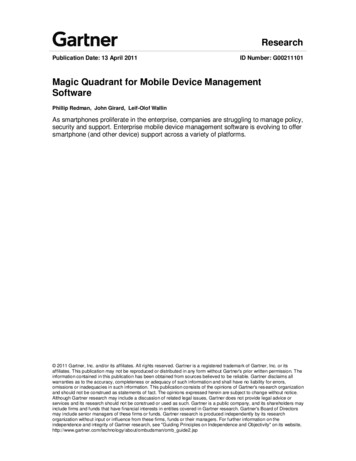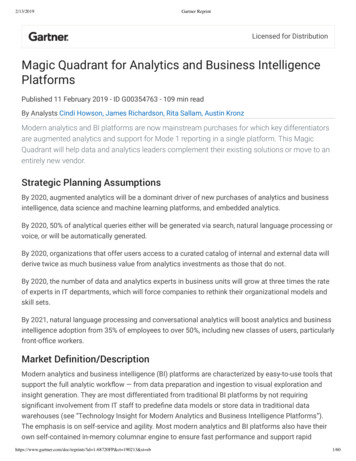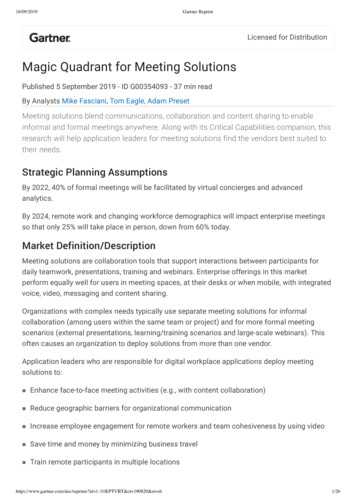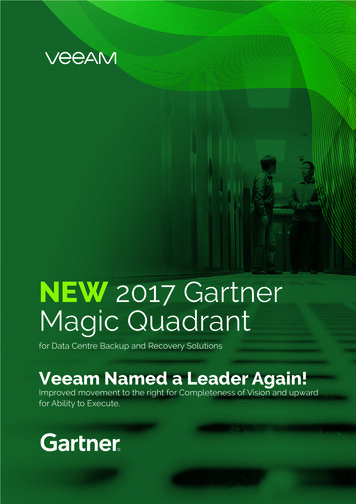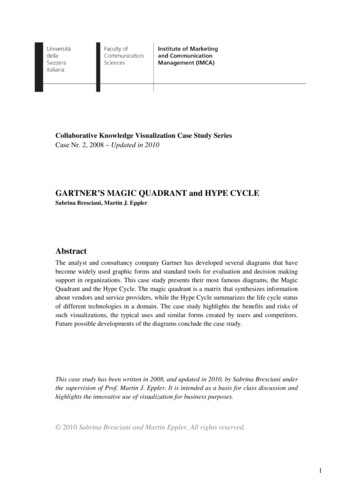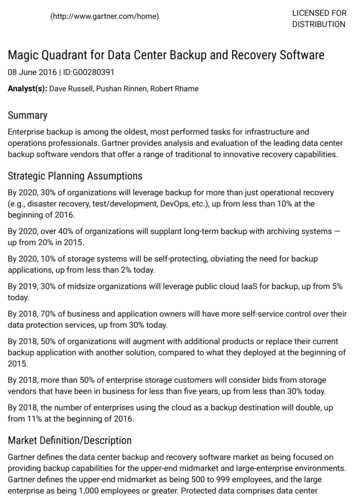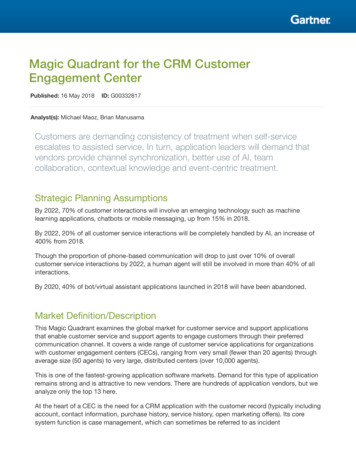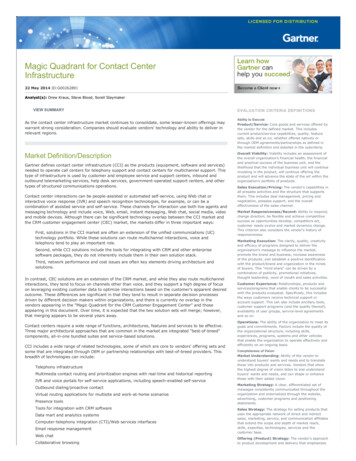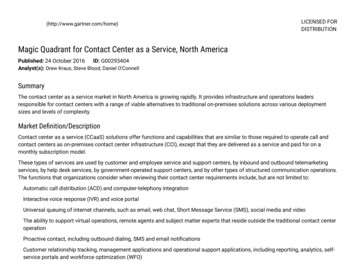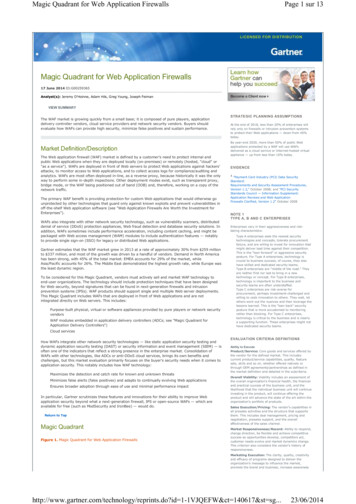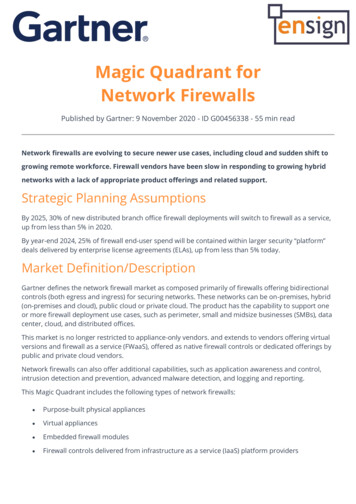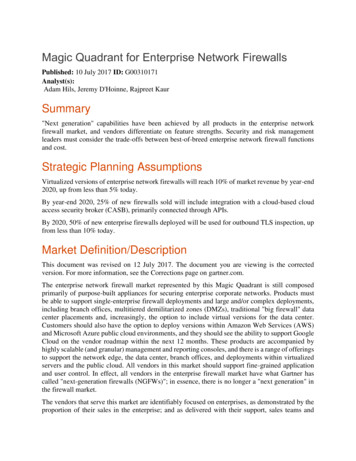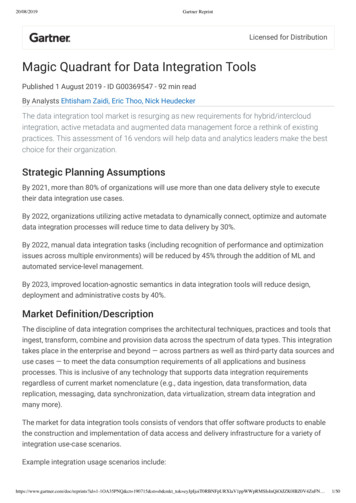
Transcription
20/08/2019Gartner ReprintLicensed for DistributionMagic Quadrant for Data Integration ToolsPublished 1 August 2019 - ID G00369547 - 92 min readBy Analysts Ehtisham Zaidi, Eric Thoo, Nick HeudeckerThe data integration tool market is resurging as new requirements for hybrid/intercloudintegration, active metadata and augmented data management force a rethink of existingpractices. This assessment of 16 vendors will help data and analytics leaders make the bestchoice for their organization.Strategic Planning AssumptionsBy 2021, more than 80% of organizations will use more than one data delivery style to executetheir data integration use cases.By 2022, organizations utilizing active metadata to dynamically connect, optimize and automatedata integration processes will reduce time to data delivery by 30%.By 2022, manual data integration tasks (including recognition of performance and optimizationissues across multiple environments) will be reduced by 45% through the addition of ML andautomated service-level management.By 2023, improved location-agnostic semantics in data integration tools will reduce design,deployment and administrative costs by 40%.Market Definition/DescriptionThe discipline of data integration comprises the architectural techniques, practices and tools thatingest, transform, combine and provision data across the spectrum of data types. This integrationtakes place in the enterprise and beyond — across partners as well as third-party data sources anduse cases — to meet the data consumption requirements of all applications and businessprocesses. This is inclusive of any technology that supports data integration requirementsregardless of current market nomenclature (e.g., data ingestion, data transformation, datareplication, messaging, data synchronization, data virtualization, stream data integration andmany more).The market for data integration tools consists of vendors that offer software products to enablethe construction and implementation of data access and delivery infrastructure for a variety ofintegration use-case scenarios.Example integration usage scenarios include:https://www.gartner.com/doc/reprints?id 1-1OA35PNQ&ct 190715&st sb&mkt tok FN 1/50
20/08/2019Gartner Reprint Data integration and delivery for optimized analytics — Accessing, queueing or extracting datafrom operational systems; transforming and merging that data virtually or physically; anddelivering it through an integrated approach for optimized and repeatable analytics (such asthose delivered via the data warehouse) and data science purposes. Sourcing and delivery of master data in support of master data management (MDM) —Enabling the connectivity and integration of data representing critical business entities, such ascustomers, products and employees. Data integration tools can be used to integrate,consolidate and synchronize master data related to critical business processes. Data consistency between operational applications — Ensuring database-level consistencyacross applications, on both an internal and an interenterprise basis. This could involvesynchronizing data structures for on-premises applications or cloud-resident data sources inSaaS, and for bidirectional or unidirectional consistency. Interenterprise data acquisition and sharing — For providing data to, and receiving data from,external trading partners (customers, suppliers, business partners and others). Someinterenterprise data sharing requirements involve on-premises or cloud-based environments, ora combination of both. Data integration tools may be used to support data acquisition, sharingand collaborations across applications, which often consist of the common types of dataaccess, transformation and movement components that are also found in other use cases. Data services orchestration — Deploying all aspects of runtime data integration functionality asdata services (for example, deployed functionality can be called via a web services interface). Data migration and consolidation — Addressing the data movement and transformation needsof data migration and consolidation, such as the replacement of legacy applications, databasesor both. Although most are often addressed through custom coding of conversion programs,data integration tools can provide significant support to enterprises undertaking large-scaledata migration projects (often due to mergers and acquisitions, modernization orconsolidation). However, it should be clear that data integration tools alone do not solve all datamigration challenges. Support for data governance and management of data assets — Increasingly, data integrationtools are expected to collect, audit, govern, share and monitor data regarding the deployed dataintegration service and processes in the organization. The ability to profile new data assets andrecognize their similar nature and use cases, as compared to other data currently integrated, isgrowing in importance.Data integration tools may display characteristics that combine aspects of the individual use-casescenarios listed above. Technologies in this market are required to execute many of the corefunctions of data integration, which can be applied to any of the above scenarios. (For a detailedlist and analysis of all evaluation components and functions, see Note 1.)Some examples of new and differentiating functionality or characteristics include:https://www.gartner.com/doc/reprints?id 1-1OA35PNQ&ct 190715&st sb&mkt tok FN 2/50
20/08/2019Gartner Reprint Interoperating with application integration technology in a single solution architecture — Thisis now go far beyond supporting extraction, transformation and loading (ETL) processes. It caninclude layered data services such as change data capture (CDC), which can populate dataqueues, reading message services and accepting streaming data, and extend to the point ofprovisioning these processes across an enterprise service bus. Supporting data integration across hybrid cloud and intercloud environments — Hybrid cloudmeans data is spread across on-premises and cloud ecosystems, while with intercloud it isspread across different cloud infrastructure providers (see “Are You Ready for Multicloud andIntercloud Data Management?”). This is an urgent requirement, as organizations now expecttheir data integration tools to support this combination of data residing on-premises and inSaaS applications, or other cloud-based data stores and services, to fulfill requirements such ascloud service integration.This increasingly requires data integration tools to utilize both active and passive metadata(through analysis on this metadata) to recommend and, in some cases, even automate dataintegration design and infrastructure deployment (see Note 2 for the distinction between activeand passive metadata). This assists data and analytics leaders with designing more-flexibledata management architectures that account for this hybrid integration ecosystem, andreduces the need for unnecessary data replication or movement to support new data andanalytics use cases. Enabling data services for use in broader architecture approaches — An example isparticipating in hybrid integration platforms (HIPs). Or, something as simple as enabling asemantic layer, or even historian software queues in IoT and edge devices (historian software isdata that collects sensor data as a local cache in IoT environments). Supporting the delivery of data to, and the access of data from, a wide variety of data stores,repositories and data management tiers in application deployments — This includes but is notlimited to: distributed data management solutions, analytic data management repositories, datalakes and platforms typically associated with nonrelational (formerly known as NoSQLplatforms) data integration initiatives, such as Hadoop, nonrelational databases and cloudbased data stores. Nonrelational DBMS integration — This poses data integration challenges but also providesopportunities to assist in the application of schemas at data read time, if needed, and deliverdata to business users, processes or applications — or to use data iteratively. Data integrationtools must provide connectivity options to integrate different types of nonrelational DBMSs,such as key value stores, graph databases and document stores, among others.Most data integration tools are slow to roll out interfacing, integration and orchestrationfunctions with new and other popular nonrelational DBMSs, making this a differentiatingcapability. IoT/OT data convergence — Increasingly, the differing structure, latency and throughputrequirements of IoT or machine data is introducing new integration requirements. This data ishttps://www.gartner.com/doc/reprints?id 1-1OA35PNQ&ct 190715&st sb&mkt tok FN 3/50
20/08/2019Gartner Reprintsometimes integrated through stream data integration capabilities, and at other times stored intime-series databases. Such integration requirements are now expected to be addressed bymodern data integration tools for IT/OT data convergence. Self-service data integration — Finally, there is an increasing expectation of organizations toallow business users or citizen integrators to be able to integrate “their own data” through datapreparation tools and techniques. The notion of data management being able to govern andcontrol the flow in a synergistic manner through the data integration tool is a challenge thatdata integration tool vendors are expected to solve.In recent years, significant submarkets have emerged in parallel to the main market offerings.These represent a renewed focus on either vision or execution, but do not address all dataintegration and delivery requirements. There are tools that focus on innovative solutions andmodern data delivery styles, such as data virtualization, data preparation or stream dataintegration, among others. These allow organizations to include these new capabilities to supporttheir new data integration requirements. Such requirements include a focus on data virtualization,stream data integration and data preparation, but also specific delivery to support management ofdata lakes (see “Market Guide for Data Preparation Tools,” “Adopt Stream Data Integration to MeetYour Real-Time Data Integration and Analytics Requirements” and “Market Guide for DataVirtualization”).Magic QuadrantFigure 1. Magic Quadrant for Data Integration Toolshttps://www.gartner.com/doc/reprints?id 1-1OA35PNQ&ct 190715&st sb&mkt tok FN 4/50
20/08/2019Gartner ReprintSource: Gartner (August 2019)Vendor Strengths and CautionsActianActian is based in Palo Alto, California, U.S. and, including embedded/OEM deployments, hasmore than 8,000 data integration tool customers. It offers the DataConnect product set, whichincludes integration tools, technology and services for on-premises deployment through virtualprivate cloud, multitenant integration platform as a service (iPaaS) and embedded datamanagement.Note: Actian was jointly acquired by HCL Technologies and Sumeru Equity Partners in July ?id 1-1OA35PNQ&ct 190715&st sb&mkt tok FN 5/50
20/08/2019Gartner Reprint Relevance of targeted capabilities. Actian continues to leverage its lightweight and small-footprint tool in order to drive long-lasting revenue. As an easily embeddable data integrationtool, DataConnect stabilizes quickly and almost bypasses reviews considering its replacement— often for years. Reference customers cited the vendor’s ease of use, reliability and ability tohandle complex workloads. Opportunity to improve market awareness and mind share. Actian has an established variety ofdata integration and data management and analytics tools, often with separate go-to-marketapproaches. As an acquirer, HCL Technologies should provide substantial reseller, systemintegrator (SI) and OEM partnership opportunities through leveraging its global ecosystem. Processing optimization. Actian’s data integration tool maintains in-line statistics for data thatcrosses the integration platform. This continues to be a strength — combining capacity,utilization, data statistics, data profiling and many other components to create a combination ofoperational alerts for system health and regarding changes in the data, for users anddevelopers alike.Cautions Acquisition uncertainty. We consider the acquisition by HCL Technologies to be one thatrequires a careful balance between maintaining the current embedded solutions business, anda professional services organization subsuming the tool completely. Actian has assuredGartner that it will continue to operate as a separate legal entity after acquisition. Existingcustomers and prospects can assume with some confidence that, even if brand dilution doesoccur, the embedded solutions should have a long technology and support life. Lacks role-based delivery. DataConnect is focused on traditional data integration experts, whodeliver integration as part of an application development or in the capacity of supporting dataengineering. However, Actian’s roadmap involves introducing an integrated design studio tosupport varying roles (including citizen integrators), through the inclusion of guideddevelopment workflows, templates, community knowledge, and issue resolution. Installed base is primarily for bulk/batch integration. Actian’s primary data integration styleremains bulk/batch-oriented. While most organizations begin with bulk/batch-based dataintegration, this could be a limiting factor if they need to combine bulk/batch with other moderndata integration styles (such as data virtualization, for example). The vendor needs to expandthe breadth of its data delivery methods to include data preparation, data virtual
Magic Quadrant Figure 1. Magic Quadrant for Data Integration Tools sometimes integrated through stream data integration capabilities, and at other times st ored in time-series databases. Such integr ation requirements are now expected to be addressed by modern
